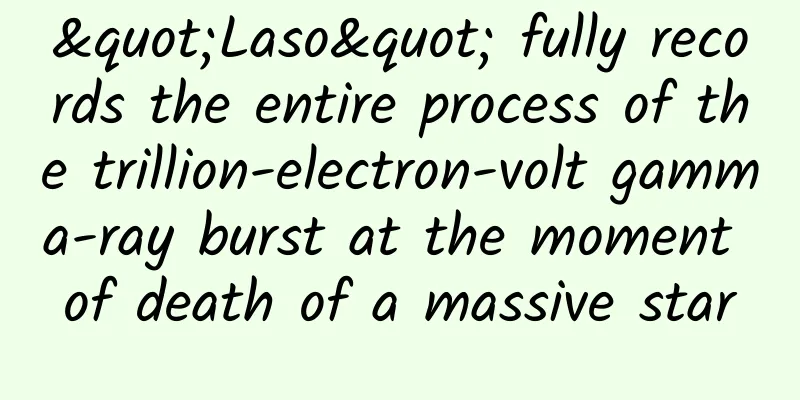"Laso" fully records the entire process of the trillion-electron-volt gamma-ray burst at the moment of death of a massive star

|
On June 9, 2023, the latest observational research results of the High Altitude Cosmic Ray Observatory (LHAASO) on the gamma-ray burst (GRB) named GRB 221009A were published online in the journal Science, titled "A tera-electronvolt afterglow from a narrow jet in an extremely bright gamma-ray burst 221009A". The paper was completed by the LHAASO international collaboration. About 2 billion years ago, a "super sun" massive star that was more than 20 times heavier than the sun burned up its nuclear fusion fuel and collapsed instantly, triggering a huge explosion fireball, which emitted a huge "cosmic fireworks" gamma-ray burst that lasted for hundreds of seconds. The large number of trillion electron volt high-energy gamma photons produced by the collision of the fireball and interstellar matter flew through the vast universe and directly toward the earth, and arrived at the field of view of "Laso" at 21:20:50 on October 9, 2022. More than 60,000 gamma photons were collected by "Laso". After several months of analysis, scientists finally unveiled the veil of this explosion. Lasso accurately measures the entire process of a high-energy photon burst for the first time The signal details collected by LHAASO show that the detected photons come from the after-explosion after the main explosion. The "main explosion" of a gamma-ray burst event, also known as transient radiation, is a huge explosion in the initial stage, manifested as strong low-energy gamma-ray radiation. The collision of the explosive close to the speed of light with the surrounding gas produces a "after-explosion", also known as afterglow. "For the first time, LHAASO has accurately observed the complete process of the "after-explosion", recording the entire stage of the enhancement and attenuation of the trillion electron volt gamma-ray flux." said Cao Zhen, chief scientist of the LHAASO project, spokesperson for the LHAASO international cooperation group, and researcher at the Institute of High Energy Physics of the Chinese Academy of Sciences. With the observation of tens of thousands of gamma-ray bursts, scientists have established a seemingly perfect theoretical model and even firmly believe in it. "Laso" has achieved a textbook-like complete observation of the light variation process in the high-energy band that other experiments have not achieved, providing an experimental basis for the precise verification of the theoretical model. Given the rarity of this burst, which occurs only once in a thousand years, this observation result is expected to remain the best for decades or even hundreds of years to come. The rapid enhancement of high-energy photon flux was measured for the first time by the Lasso "During the aftermath of the explosion, 'Lasor' detected for the first time a very rapid increase in photon flux," said Yao Zhiguo, one of the corresponding authors of the paper and a researcher at the Institute of High Energy Physics of the Chinese Academy of Sciences. The flux increased by more than 100 times in less than two seconds, and the subsequent slow growth behavior was consistent with the expected characteristics of the aftermath of the explosion. Such a rapid enhancement phenomenon in the early stage exceeded the expectations of previous theoretical models. What kind of mechanism is there? The observation results published this time will trigger in-depth discussions in the scientific community on the mechanisms of gamma-ray burst energy injection, photon absorption, particle acceleration, etc. "Laso" discovered the secret of the brightest gamma-ray burst in history Observations from the Lasso show that the brightness of the high-energy radiation suddenly and rapidly decreased at a certain moment less than 10 minutes after the detonation. "This can be explained by the ejecta after the explosion being a jet-like structure, and the brightness dropped rapidly when the radiation angle expanded to the edge of the jet." said Wang Xiangyu, one of the corresponding authors of the paper and a professor at Nanjing University. Because this brightness transition occurred very early, the angle of the jet measured was also extremely small, only 0.8 degrees. This is the jet with the smallest angle known to date, which means that what was observed was actually the brightest core of a typical jet that is bright inside and dark outside. "It is precisely because the observer happened to be facing the brightest core of the jet that naturally explains why this gamma-ray burst is the brightest in history, and why such events are extremely rare." said Dai Zigao, one of the corresponding authors of the paper and a professor at the University of Science and Technology of China. The high-statistical observations of Lasso at the highest energy band will reveal more mysteries During the ten minutes of this event, the number of photons recorded by Lasso exceeded the accumulation of observations of the "standard candle" **** Crab Nebula in the past few years. "If the selection conditions are reduced to the minimum, the number of photons can reach 100,000!" said Cha Min, one of the corresponding authors of the paper and a researcher at the Institute of High Energy Physics of the Chinese Academy of Sciences. Compared with other experimental devices in the same energy range, even those specially designed to track gamma-ray bursts, the number of photons they measured was only below a thousand, and they only measured the "afterglow" 60 seconds after the explosion. "As of now, there are many other new discoveries in this explosion event. Scientists are still working tirelessly on the data of Lasso to try to reveal more mysteries. Please wait for the follow-up data analysis results of Lasso." Cao Zhen gave an optimistic expectation for the next stage of LHAASO's results. Figure 1: Lasso observed the gamma-ray burst GRB 221009A with a high significance level of more than 250 times the standard deviation. Figure 2: The intrinsic spectrum and observed spectrum of the gamma-ray burst 221009A measured by "LASSO" in five time periods, with an energy range of approximately 200 billion to 7 trillion electron volts. Figure 3: The light variation process and energy spectrum index evolution of the afterglow radiation of GRB221009A in the energy range of 300 billion to 50 trillion electron volts observed by Lasso, as well as the function fitting. Lasso has achieved the first complete observation of the afterglow radiation process of a gamma-ray burst above 100 billion electron volts, discovered the rapid growth phenomenon of the afterglow radiation process, and discovered the rapid decay phenomenon of the afterglow radiation process of the gamma-ray burst GRB221009A. Source: Institute of High Energy Physics, Chinese Academy of Sciences |
Recommend
iQIYI QiLin Performance Advertising Summer Strategy
Data shows that summer traffic generally shows an...
The biggest difference between Chinese and American companies in data analysis: the practice of growth hacking
1. Spending money ≠ growth, data-driven is a capa...
Oh my god, the glasses cloth is not used to wipe glasses!
Planning and production Source: Dr. Curious (ID: ...
[Practical Tips] Six major application markets teach you how to run the Android market!
Some optimization techniques for the domestic And...
Sea salt, iodized salt, low sodium salt... How to choose between different types of salt? Many people eat the wrong salt
In the past two days, "buying salt" and...
There is a secret hidden in this position on the RMB, remember to touch it when putting the red envelope in!
Today is Chinese New Year's Eve. Are you read...
Why hasn't the smallpox virus been eradicated?
Recently, the Global Times reported that frozen b...
0-1 Product operation strategy for building a mutual financial P2P platform
Having been in the Internet finance industry for ...
Does your stomach really get bigger the more you eat? Does dieting shrink it? The truth is...
Myth: "The more you eat, the bigger your sto...
What makes the unhappy home life even worse? It's stiff neck...
During the epidemic, the thing people fear most i...
The more an ad looks like information, the more likely it is to be clicked? Please stop hurting your users.
There is a saying in current information flow ads...
How to do community operation? Positioning and user analysis are equally important!
Community operation is currently a popular operat...
To master the promotion of Bilibili, just read this article!
Bilibili , the main battlefield to capture young ...
How to build a private domain traffic matrix to acquire a large number of customers?
The author and a good friend from a ToB company t...
TSMC's 2nm trial production yield has reached 60%, and it is expected that the monthly production capacity will reach 50,000 wafers by the end of 2025
TSMC's plan to quickly deliver the first 2nm ...









